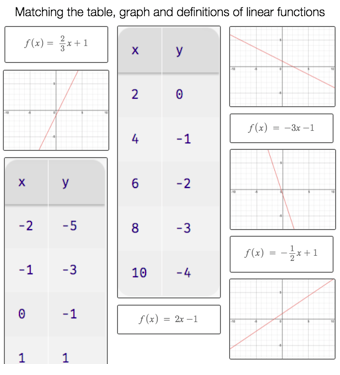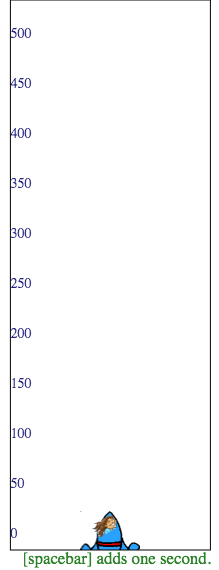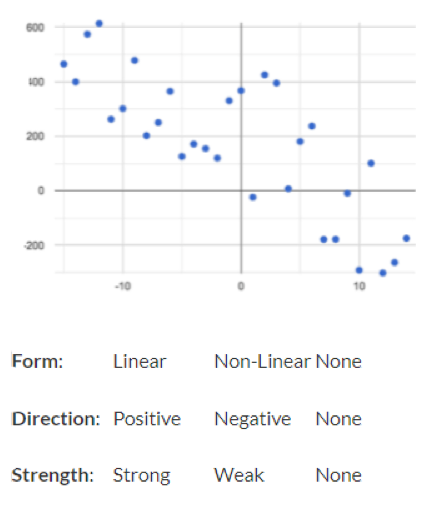Like IM 6–8 Math™, Bootstrap is field-tested and research-validated, with a focus on deep exploration that supports and engages all kinds of learners. Our integrated computing modules have been proven to support math transfer and can be mixed and matched to supplement what you’re already doing in your classroom. Teaching 8th grade math with Bootstrap also addresses many CS Standards, including: 1B-AP-10, 2-AP-1, 2-AP-10, 2-AP-11, 2-AP-12, 2-AP-13, 2-AP-14, 2-AP-17, 2-AP-19, 3B-AP-14, and 3B-AP-21.
| IM Unit |
Integrated Computing Lessons that can extend the IM Unit |
|
-
Simple code allows students to experiment with rotating, scaling, and reflecting images of shapes, text or anything from the web.
-
Practicing transformations with their own names is highly motivating.
-
In seconds, students can adjust the degree of rotation and get visual feedback on how the numbers transform the images.
|
|
|
|
-
Students solve a classic function word problem about the velocity and height of a rocket - and then write simple code to see the rocket blast off.
-
Students can even modify the code to change the speed and direction of the rocket!
-
Using the Design Recipe - a tool that empowers students both as coders and mathematicians - students solve word problems that interweave the development of the function concept with 3D geometry concepts.
-
In our engaging and interactive computing context, students are offered many opportunities to analyze word problems and identify the domain, range, and other quantities.
-
A fictional restaurant owner, Alice, solicits students’ help in improving some code used to calculate customers' bills. As students analyze the code, they dig into the concept of piecewise functions in a meaningful and engaging new context.
-
Videogames rely on piecewise functions for player animation! The video game project offers an exciting opportunity to apply new and otherwise abstract mathematical knowledge.
|
|
-
As a class, your students will search out correlations in a dataset, discussing and analyzing the form, direction, and strength of the linear relationships they see in the scatterplots they generate.
-
Students repeat this process in a dataset of their choice, one that sparks their interest. Simple code enables students to use linear regression to quantify patterns in their dataset..
-
Our data science curriculum leverages students' curiosity about the world around them to inspire real data analysis and original research. Individual lessons are impactful regardless of whether you opt to facilitate the culminating research project or not.
|
These materials were developed partly through support of the National Science Foundation,
(awards 1042210, 1535276, 1648684, and 1738598).  Bootstrap by the Bootstrap Community is licensed under a Creative Commons 4.0 Unported License. This license does not grant permission to run training or professional development. Offering training or professional development with materials substantially derived from Bootstrap must be approved in writing by a Bootstrap Director. Permissions beyond the scope of this license, such as to run training, may be available by contacting contact@BootstrapWorld.org.
Bootstrap by the Bootstrap Community is licensed under a Creative Commons 4.0 Unported License. This license does not grant permission to run training or professional development. Offering training or professional development with materials substantially derived from Bootstrap must be approved in writing by a Bootstrap Director. Permissions beyond the scope of this license, such as to run training, may be available by contacting contact@BootstrapWorld.org.
 Bootstrap by the Bootstrap Community is licensed under a Creative Commons 4.0 Unported License. This license does not grant permission to run training or professional development. Offering training or professional development with materials substantially derived from Bootstrap must be approved in writing by a Bootstrap Director. Permissions beyond the scope of this license, such as to run training, may be available by contacting contact@BootstrapWorld.org.
Bootstrap by the Bootstrap Community is licensed under a Creative Commons 4.0 Unported License. This license does not grant permission to run training or professional development. Offering training or professional development with materials substantially derived from Bootstrap must be approved in writing by a Bootstrap Director. Permissions beyond the scope of this license, such as to run training, may be available by contacting contact@BootstrapWorld.org.



